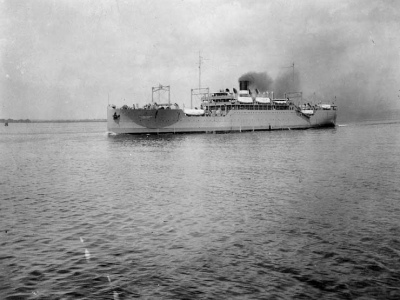
Статус в конвое: Грузовое судно
Год постройки: 1920 г.
Страна: 
Принадлежность: Belgian shipping company
Участие в конвоях: PQ-1, QP-2,
The U.S. Army Transport Cantigny, a 7555 gross ton troopship, was completed at Hog Island, Pennsylvania, in August 1920. She was the second ship of her design (Hog Island Type B) to be laid down (on Armistice Day, 11 November 1918) and the first to be launched. USAT Cantigny made one trooping voyage to Panama and then commenced a series of crossings between New York and Antwerp, Belgium, repatriating American forces from Europe. The Army soon found her surplus to its needs and laid her up, probably following her return to New York from Antwerp in September 1921.
In late 1923 and early 1924 Cantigny and four idle sisters were transferred to the U.S. Shipping Board, given names beginning with American, and placed in commercial service between New York and London as freighters with berths for 16 passengers. Their passenger accomodations were increased to around 90 persons in 1926. American Banker (ex-Cantigny) remained in operation between the United States and London until laid up following the September 1939 outbreak of World War II and the November 1939 Neutrality Act, which prevented American flag ships from calling at belligerent ports. In early 1940 her American owners set up a Belgian shipping company, and the eight idle American ships transferred to it were able to resume operations, although under Belgian names. American Farmer returned to sea in March 1940 as Ville d'Anvers. She was the only one of the eight Belgian, ex-American, ships to survive World War II.
Following World War II her American owners re-registered the Ville d'Anvers under the Honduran flag, retaining her Belgian name, and operated her as a freighter. She re-entered passenger service in November 1946 with 200 berths under the name City of Athens, but the identity of her new owners, probably Italian or Greek, was never revealed. In late 1947 she was refitted as the migrant carrier Protea with berths for over 1000 persons in bunkhouse accomodations that were, according to one historian, possibly the worst of any European owned and oriented vessel of her day. Her accommodations were reduced to 900 and vastly improved after she was renamed Arosa Kulm in 1952. The old "Hog Islander" was arrested for debt in 1958 and sold for scrapping in 1959.